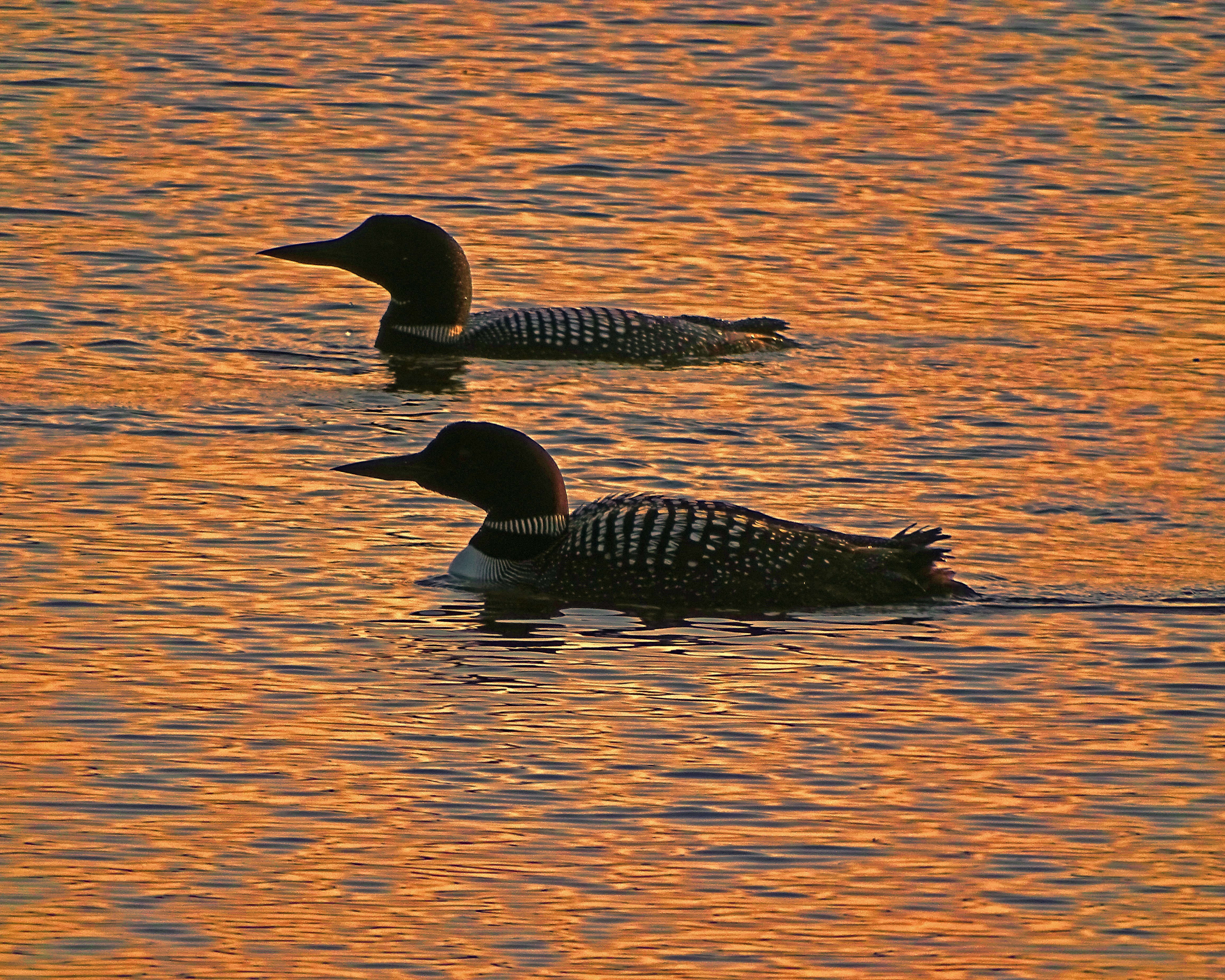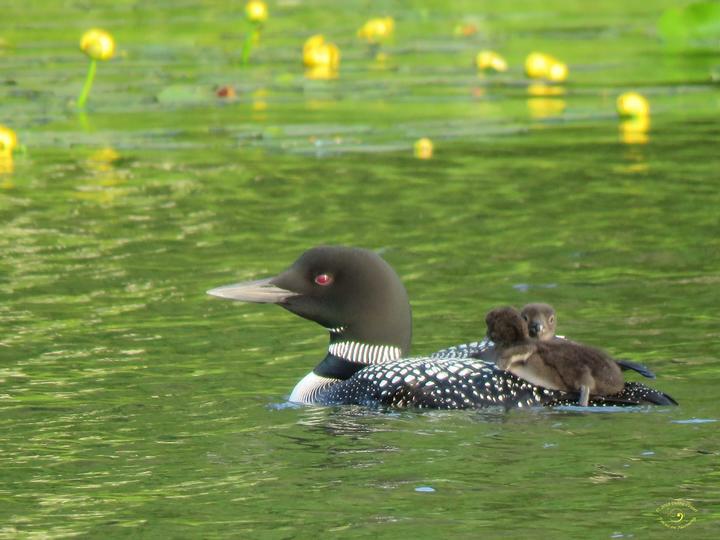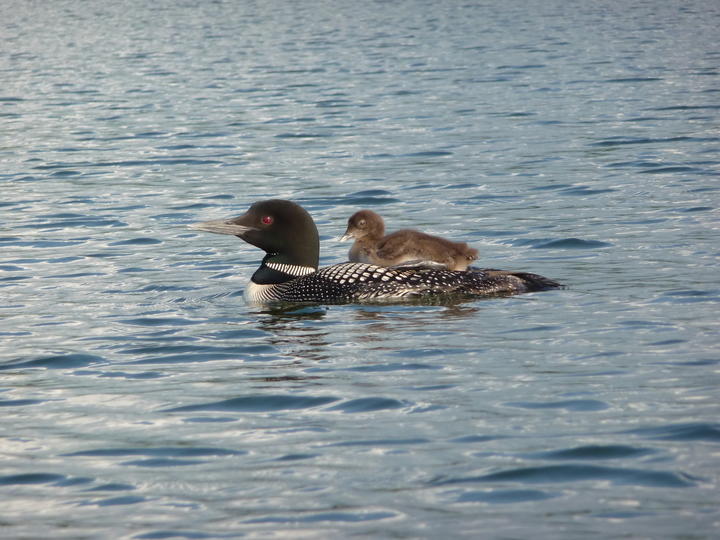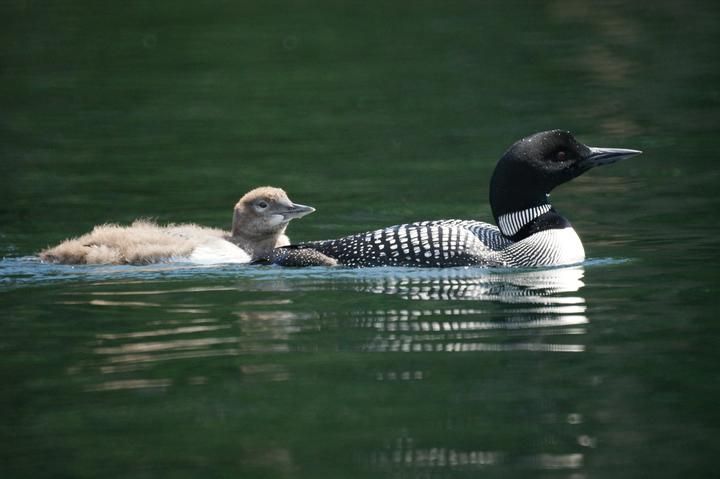More names for this bird
Dakota: Bdoza
The Dakota and Anishinaabe were among the earliest people to name Minnesota’s plants and animals, as well as to understand them in relation to Minnesota’s climate and seasons. Those original names are still in use, and several are included on the Season Watch website. However, complete translations were not available.
Latin (or scientific name): Gavia immer
The scientific community has a convention of assigning agreed-upon Latin names to every kind of organism. Using scientific names helps people communicate confidently about the same organism and organize lifeforms based on how closely related they are.
More common names: Great northern diver, great northern loon
Page contents
About the common loon

August 1, 2014, Schoolcraft County, Michigan
Photo by USFWS Midwest via Wikimedia Commons, Public Domain
About the common loon
- The common loon is a diving water bird larger than a crow but smaller than a goose.
- In spring and summer, it is black with white spots on top and white underneath. It has a different plumage during fall and winter which is gray on top and white underneath.
- Loons nest in hidden and protected areas along lake shorelines. They will also use human-made nesting platforms.
- Fun fact: Loons are like airplanes in that they need a runway for takeoff. In order to gain enough speed for lift-off, they need from thirty yards to a quarter mile (depending on the wind) to across the top of the water while flapping their wings.
- Common loons migrate. Expand the "Migration animation" section below to learn more.
Migration animation
Migration animation
Click the full-frame icon (lower right corner of video) to play at full size.
More about eBird's abundance animations
eBird data from 2006-2020. Estimated for 2020. Fink, D., T. Auer, A. Johnston, M. Strimas-Mackey, O. Robinson, S. Ligocki, W. Hochachka, L. Jaromczyk, C. Wood, I. Davies, M. Iliff, L. Seitz. 2021. eBird Status and Trends, Data Version: 2020; Released: 2021. Cornell Lab of Ornithology, Ithaca, New York. https://doi.org/10.2173/ebirdst.2020
Visual guide to phenology
Watch for changes in loons' presence (or absence), abundance, and behaviors at different times of year. Also, pay attention to when young-of-year fledge and develop.
Note to observers
This page explains general clues to watch and listen for when observing common loon phenology. However, this page does not explain how to identify this bird or collect data in a standardized way.
- For help with identification, see The Cornell Lab's All About Birds.
- For guidance on collecting data, see Nature’s Notebook.
Audio resources
A bird's song is a special vocalization associated with breeding behaviors such as setting up and defending territories, finding mates, and courtship. The first two recordings below are examples of the common loon's song.
Recording by Fernand DEROUSSEN (www.xeno-canto.org/138264) CC BY-NC-ND 3.0
Recording by Jonathon Jongsma (www.xeno-canto.org/139387) CC BY-SA 3.0
This recording includes one song (at 0:05) amid many calls.
Recording by David Bradley (www.xeno-canto.org/18690) CC BY-NC-ND 2.5
Loons call year-round, though they are not present in Minnesota year-round. After recognizing a loon's call, the next step is to locate the bird and watch for behavioral clues to its life cycle stage or activities. Here are two examples of calls by common loons:
Recording by Bobby Wilcox (www.xeno-canto.org/276989) CC BY-NC-SA 4.0
Recording by Lance A. M. Benner (www.xeno-canto.org/593646) CC BY-NC-SA 4.0
Graphs and historical data
Note: The Orientation Center provides a map, as well as information on reading graphs; interpreting summary statistics, who collected the data and how; and how to download datasets for independent exploration.
First seen
- Earliest: March 24 (occurred in 2012)
- Average: April 10
- Latest: April 25 (occurred in 2013)

First heard
- Earliest: April 12 (occurred in 1999 and 2009)
- Average: April 22
- Latest: May 21 (occurred in 2002)

Arrival
- Earliest: March 12 (occurred in 2002)
- Average: April 7
- Latest: April 30 (occurred in 2013)

More resources
Keep exploring Season Watch
Keep exploring Season Watch
Co-author: Jayme Hogan, Minnesota Master Naturalist













